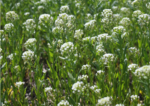Advertise Follow Us
Items Tagged with 'double-cropping'
ARTICLES
New Lines of Winter Camelina Show Promise for Profitable Relay Cropping
University of Minnesota scientists are tweaking winter camelina lines to provide Northern Plains growers a profitable winter cover crop to supplement corn-soybean rotations.
Read More
Rotations, Double-Cropping Key Profitable No-Till Makeover
Oklahoma no-tiller Preston Simic is rejuvenating stagnant wheat ground by protecting it with residue, fixing fertility issues and diversifying crop rotations.
Read More
Fertility, Covers, Precision Inputs Form Complete No-Till Package
Bill Murr leverages the soil-building benefits of no-till with strategic nutrient, weed and disease management on his 3,400-acre farm in northeast Kansas.
Read More
Double Up No-Till Benefits By Cover Cropping For Forage
Cover crops serve up more than just soil benefits. They can boost a no-tiller’s bottom line when used as feed for their livestock, experts say.
Read More










